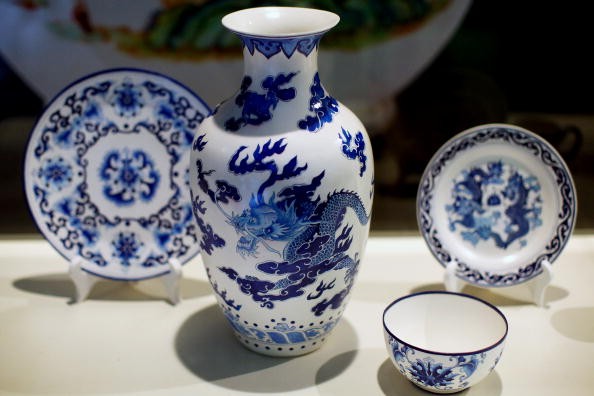Rejected Ming Dynasty Porcelain Finally on Display in Forbidden City After 6 Centuries
| Benjie Batanes | | Aug 11, 2015 10:22 AM EDT |
(Photo : Photo by Feng Li/Getty Images) Several rejected porcelain items from the Ming-era are on display in the Forbidden City after undergoing restoration.
Chinese experts have successfully restored a number of Ming Dynasty porcelain that were discarded in the ancient times because they were considered to be of inferior quality. They are currently on display in the museum section of the Forbidden City in Beijing until September 3.
Xinhua reported that more than 150 pieces of porcelain that were rejected by the Ming imperial court were discovered in the town of Jingdezhen, which is located in the Chinese province of Jiangxi. During the Ming Dynasty, the town was famous for producing porcelain products for the imperial court.
Like Us on Facebook
The Palace Museum's Utensil section assistant head Lu Chenglong said they have been planning to show the unique porcelain items for the past 25 years.
It is only in 2015 that the various parties involved have finally agreed to ship the rejected porcelain items from the town that they were discovered to Beijing.
More than a hundred quality porcelain works that were produced from the same furnace as the rejected ones will also be displayed for comparison.
Wu, a local antique dealer, said most royal court porcelain rejects have not been shaped properly or have inconsistent picture drawings or colors.
For more than 40 years, local archaeologists have been successful in discovering and reconstructing more than a thousand porcelain works.
The assistant director said that porcelain reconstruction takes a lot of time, but the lessons they have learned from them is enough reward.
The number of ancient Chinese porcelain currently in existence are quite few, and the knowledge of how these work of arts were made have been lost through time.
With the recent excavations of ancient porcelain including the furnace from which they have been made, Chinese archaeologists are now able to get an idea of how their ancient ancestors created various porcelain items.
After washing away the dirt, most ancient porcelain appeared in their pristine condition despite being buried underground or sitting in the bottom of the sea for many centuries.
During the late 16th century until the early 17th century, Jingdezhen was home to more than 100,000 porcelain makers. Their works not only made it in the Ming imperial palaces but were also shipped to various countries outside China.
TagsMing Dynasty, chinese royal court, Forbidden City, porcelain rejects, ancient porcelain works, China Palace Museum, Lu Chenglong, Jingdezhen, porcelain town
©2015 Chinatopix All rights reserved. Do not reproduce without permission
EDITOR'S PICKS
-

Did the Trump administration just announce plans for a trade war with ‘hostile’ China and Russia?
-

US Senate passes Taiwan travel bill slammed by China
-

As Yan Sihong’s family grieves, here are other Chinese students who went missing abroad. Some have never been found
-

Beijing blasts Western critics who ‘smear China’ with the term sharp power
-

China Envoy Seeks to Defuse Tensions With U.S. as a Trade War Brews
-

Singapore's Deputy PM Provides Bitcoin Vote of Confidence Amid China's Blanket Bans
-

China warns investors over risks in overseas virtual currency trading
-

Chinese government most trustworthy: survey
-

Kashima Antlers On Course For Back-To-Back Titles
MOST POPULAR
LATEST NEWS
Zhou Yongkang: China's Former Security Chief Sentenced to Life in Prison

China's former Chief of the Ministry of Public Security, Zhou Yongkang, has been given a life sentence after he was found guilty of abusing his office, bribery and deliberately ... Full Article
TRENDING STORY

China Pork Prices Expected to Stabilize As The Supplies Recover

Elephone P9000 Smartphone is now on Sale on Amazon India

There's a Big Chance Cliffhangers Won't Still Be Resolved When Grey's Anatomy Season 13 Returns

Supreme Court Ruled on Samsung vs Apple Dispute for Patent Infringement

Microsoft Surface Pro 5 Rumors and Release Date: What is the Latest?













